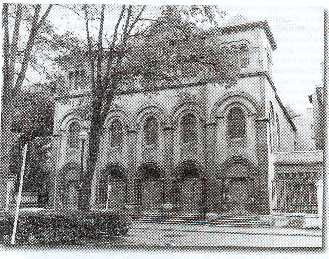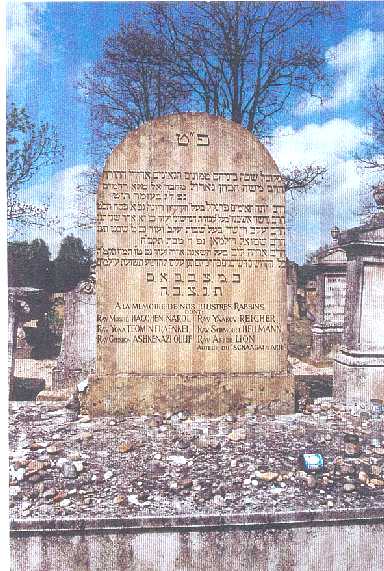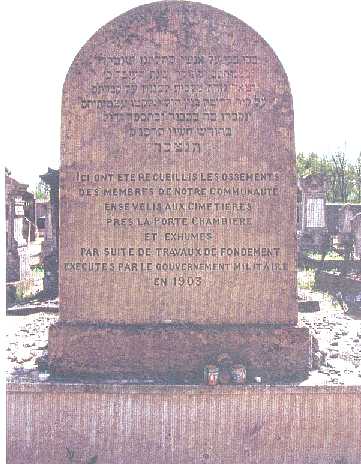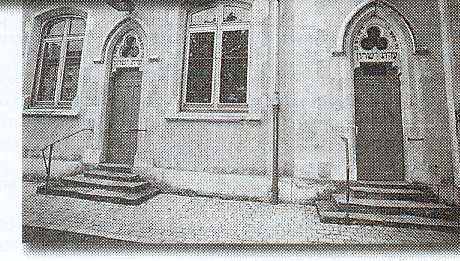METZ
The Jewish community of Metz is characterized
by its antiquity, the size of its past and its spiritual radiation.
Even if the presence of the Jews at the time Roman is probable, the first mention
of their existence, undoubtedly in a number, in our city, goes up to 888, at
the time of a council the attacker. The Jews, at that time, are merchants, cultivate
the ground and have vineyards.
They live until XIth century under the protection of the bishop and live Jurue
(street of the Jews).
 Metz is a hearth of study of the
Law. Towards 960 is born in our city Rabbéeou Guerchon. Its prestige
in the Jewish world was worth to him the title of " Light of the exile
". It has the appearance of a spiritual chief of the Jews of the time.
Its decisions, whose prohibition of polygamy in Europe, still make authority
nowadays.
Metz is a hearth of study of the
Law. Towards 960 is born in our city Rabbéeou Guerchon. Its prestige
in the Jewish world was worth to him the title of " Light of the exile
". It has the appearance of a spiritual chief of the Jews of the time.
Its decisions, whose prohibition of polygamy in Europe, still make authority
nowadays.
However, the first crusade involved massacres
in Metz into 1096.
Towards the end of XIIth century or at the beginning of XIIIth century, the
Jews undoubtedly disappeared from Metz for economic reasons.
They obtained the authorization to be restored
in Metz only into 1565. They had to discharge heavy taxes to have the right
to reside. In 1595, a community was made up and it bought into 1619 a ground
to bury there its deaths not far from the current cemetery. A first synagogue
was established into 1619.
The Jews live under the protection of kings de
France who grant letters patent to them but are often subjected to the hostility
of the Metz population.
Louis XIV visited the synagogue into 1657.
The Jewish community lived the district of the
current synagogue. It always sought like rabbis of the scholars, often of the
remote regions and made teaching one of its priority tasks. This involved a
great radiation in the Jewish world. A talmudic school was created and attracted
pupils of whole Europe.
 Among
the famous rabbis who exerted their ministry in Metz, it is necessary to quote
Jonathan ELBECHITZ and especially Arieh LOEW, author of " Schaagath Arieh
" whose reputation was and remains immense in the students of the Torah.
Its tombstone is in the current cemetery.
Among
the famous rabbis who exerted their ministry in Metz, it is necessary to quote
Jonathan ELBECHITZ and especially Arieh LOEW, author of " Schaagath Arieh
" whose reputation was and remains immense in the students of the Torah.
Its tombstone is in the current cemetery.
The community controlled itself and formed a
state in the state. It had its government, its court, its synagogue, its trade,
its
brotherhoods charitable and its doctors.
The situation of the Jews improved slightly before the Revolution.
In 1787 for its contest, the royal Company of arts and sciences of Metz put
the following question: " is it a means of making the Jews happier and
more useful to France? ".
After some adventures, the Academy decreed three prices. Among the prizes priest
abbot GREGOIRE appeared.
In front of the States General of 1789, the Jews of Metz, of Lorraine and Alsace
claimed the same taxes as the citizens, the freedom of establishment, occupation,
property and worship by preserving their organization.
The Jews of the East obtained the French citizenship only in 1791.
The Worship of the Reason involved the closing of the synagogue. The Jews of
Metz crossed the rigours of terror and reorganized afterwards.
The Jewish community spent several years to refund
its debts to pay the taxes of Ancien Regime.
Napoleon adopted an ambivalent attitude with
regard to the Jews. He organized the worship and created the central Consistory
and the departmental Consistories of which that of Metz.
In 1821 is open a talmudic school which will
become the rabbinical school of France in 1829. In spite of local resistances,
this school was transferred in Paris in 1858.
The current synagogue was inaugurated in 1850.
The German annexation of 1870 involved the departure of many families.
 But from the very start of XXth century arrived to
Metz of the Jews of central Europe. This immigration increased after the armistice
of 1918. The Jews of the villages of the Moselle also came in a number to Metz.
But from the very start of XXth century arrived to
Metz of the Jews of central Europe. This immigration increased after the armistice
of 1918. The Jews of the villages of the Moselle also came in a number to Metz.
Unfortunately, the invasion Nazi caused the deportation
and the death of more than 2000 men, women and children.
Among the rabbis of this century, it is necessary to evoke the memory of Nathan
NETTER which was the Chief rabbi in Metz during more than 50 years and of Elie
BLOCH which was the rabbi of youth and perishes with his wife and her child
in deportation.
The shortly after the war, the Jewish community reconstituted itself. It saw
the arrival of the Jews of North Africa in years 62. It is a welded community
and dynamics which remembers its great past but made its youth a pledge with
a future.
D'après N. NETTER - S. LANDMANN
- P. MENDEL
Jean-Marc KRAEMER
The synagogue " Adath Yechouroun "
A historical outline on the emigration of the Jews of the East in Metz
It is at the beginning of XIXth century, that
one finds some families of Polish origin or galician in Metz: seven in all.
In this small group lived a very pious man, Mr. Mosche BLEITRACH which became
thereafter the patriarch of this new Community.
 The synagogal rite with choruses and organ not being appropriate
for the piety of these families, they organized an office to be collected in
their prayers.
The synagogal rite with choruses and organ not being appropriate
for the piety of these families, they organized an office to be collected in
their prayers.
Thanks to the support of the Jewish Consistory of the Moselle, the old one to
warmer " Halfhen " was placed at their disposal in order to make a
house of prayers of it.
In 1912, there was already in Metz, a whole colony
of new immigrants and at that time " Adath Yechouroun was made up ".
With the declaration of the First World War,
the situation started to darken; the Austrian Jews had been called under the
flags and the Poles or the Russians sent in France; after the war in 1920, the
current of immigration in Alsace-Lorraine became very active; the new ones arrived
had already fasteners in Metz; their professions were multiple: tailors, shoe-makers,
house painters, bakers, tinmen, hairdressers, tradesmen, travellers or traders.
There were in Metz 5 offices; among those "
Schromé Schabess " under the conduit of fire the Kahlenberg Rabbi.
The companies of benevolence and sporting were numerous.
The war of 1939 drove out our brothers of their hearths; the Jewish Community
of Metz was struck hard by the Nazis; more than one third of its faithful was
exterminated and never returned from their deportation.
In 1945 a very small group of " ghosts "
arrives to Metz.
It finds only devastations and desolation there.
Of the 5 places of worship, there remains only Adath Yechouroun and in which
state, plundered, ruined.
Under the patronage of Messrs Marc FUHRMANN, Mendel BANDAGED and Nathan PRAGER,
it was proceeded to the constitution of a " COMMITTEE FOR the REBUILDING
OF ADATH YECHOUROUN ". Thanks to the physical and financial devotion of
all the members, the House of Prayers was rebuilt, and a commemorative plate
our deaths, victims of the Nazism was placed inside the temple.
To date, this synagogue is one of rare of this rite still in activity in France.
It is necessary to point out the memory of Rav Marc HEISELBECK (ZAL) which since
Lbération until 1970 governed the religious destinies and since 1971
this synagogue is under the responsibility of Dayan, Rav Maurice BAMBERGER.
Henry SCHUMANN

 Metz is a hearth of study of the
Law. Towards 960 is born in our city Rabbéeou Guerchon. Its prestige
in the Jewish world was worth to him the title of " Light of the exile
". It has the appearance of a spiritual chief of the Jews of the time.
Its decisions, whose prohibition of polygamy in Europe, still make authority
nowadays.
Metz is a hearth of study of the
Law. Towards 960 is born in our city Rabbéeou Guerchon. Its prestige
in the Jewish world was worth to him the title of " Light of the exile
". It has the appearance of a spiritual chief of the Jews of the time.
Its decisions, whose prohibition of polygamy in Europe, still make authority
nowadays. Among
the famous rabbis who exerted their ministry in Metz, it is necessary to quote
Jonathan ELBECHITZ and especially Arieh LOEW, author of " Schaagath Arieh
" whose reputation was and remains immense in the students of the Torah.
Its tombstone is in the current cemetery.
Among
the famous rabbis who exerted their ministry in Metz, it is necessary to quote
Jonathan ELBECHITZ and especially Arieh LOEW, author of " Schaagath Arieh
" whose reputation was and remains immense in the students of the Torah.
Its tombstone is in the current cemetery. But from the very start of XXth century arrived to
Metz of the Jews of central Europe. This immigration increased after the armistice
of 1918. The Jews of the villages of the Moselle also came in a number to Metz.
But from the very start of XXth century arrived to
Metz of the Jews of central Europe. This immigration increased after the armistice
of 1918. The Jews of the villages of the Moselle also came in a number to Metz. The synagogal rite with choruses and organ not being appropriate
for the piety of these families, they organized an office to be collected in
their prayers.
The synagogal rite with choruses and organ not being appropriate
for the piety of these families, they organized an office to be collected in
their prayers.